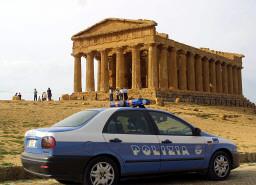The demolition of illegal buildings in one of Italy's prime archeological sites has restarted in softly-softly fashion after eight years. Bulldozers pulled down two houses in Sicily's famed Valley of the Temples between October and December, the Agrigento archeological superintendency said Wednesday.
The buildings were in the valley's Zone A, closest to the temples, where a 40-year-old construction ban is strictest.
Officials did not say why the news was not released at the time, reporting only that the owners paid for the demolition.
In the past there have been mass protests over the removal of constructions that have continued to creep up around the magnificent Greek temples along the southern Sicilian coast.
Building was officially banned in the area in 1968 but locals repeatedly flouted the heritage law.
Officials said they are now trying to acquire about 20 other buildings and pull them down.
The five Doric temples at Agrigento are one of the glories of Magna Graecia, a swathe of southern Italy which was once dotted with wealthy and culturally lavish Greek cities.
The last demolitions in Zone A were in 2000-2001 when wrecking crews with army and police escorts felled six houses.
A villa that once belonged to a Mafia boss was also demolished.
At the foot of a hill on which the Temple of Juno stands, the building finished up as property of the regional government and its last practical use was as a Mercedes dealership.
The valley, covering 1,200 hectares leading down to the sea, is one of the world's major archaeological sites, with a clutch of ancient temples dating from around 600 BC.
They gaze out over what, if the law had been applied in the past, should be largely clear countryside but is instead widely built up.
Until 2000, demolition contractors were often intimidated into pulling out of jobs but from that year their names have been kept secret.
There are another 600 completely illegal buildings in Zone A, including a restaurant which figures in the Michelin guide and homes belonging to a wide variety of social figures: an olive oil merchant, a bank branch director, a city councillor, a pharmacist, a postman and a city mortuary attendant.
A study found that 10,000, or one in five of Agrigento's 50,000 inhabitants, filed a request under a 1985 law to regularise an illegal building situation there.
It reported that 90% of all buildings in Zone A from 1970-90 were illegal.
The two houses that came down before Christmas date back to the 1970s.












